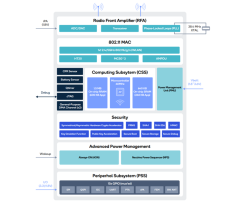Up to 88% Energy Savings: IoT Wi-Fi4 SoC QCC730

QUALCOMMs Innovative Power Managing System
Thanks to the innovative 22nm ultra-low-leakage (ULL) process from TSMC and QUALCOMM's newly designed power management system, the IoT Wi-Fi4 SoC QCC-730 achieves power savings of up to 88% compared to earlier in-house IoT products. This significantly extends battery life, which is increasingly required in applications such as wireless cameras, video doorbells, door locks, sensors, smart buildings and smart tags.
SAMPLES DOWNLOAD DATASHEETRAM Memory Type
QCC-730 is based on a Cortex-M4F processor, which is clocked at 60MHz and has access to 1.5MB RRAM (NVM) and 640KB SRAM. RRAM, referred to as Resistive Random Access Memory, is a non-volatile electronic RAM memory type that stores information by changing the electrical resistance of a weakly conductive dielectric. Of the 1.5MB, 640KB are available for the application. However, the non-volatile memory space can be expanded using XiP (eXecute in Place) via the integrated QSPI interface. XiP technology enables the processor to execute program code directly from an external serial flash memory without having to copy the code to RAM first.
Performance of the Transceiver & Data Throughput
The TCP/IP stack runs on the M4F processor, layer 2 (MAC) and layer 1 (PHY) are designed as dedicated HW and support Wi-Fi4 in dual band mode (1x1 DB 2.5GHz and 5GHz). In order to keep the power in radio operation as low as possible, the performance of the transceiver has been throttled to HT20 and MCS3 (Modulation Coding Scheme), which limits the transmission bandwidth to 20MHz and only allows a maximum of 16-QAM symbol modulation and a coding rate of ½. Nevertheless, these parameters result in a maximum TCP/UDP data throughput of 16/23Mbps, which should be more than enough for the IoT applications mentioned above. In addition, MCS3 favors a much more robust transmission compared to higher indices in terms of SNR and RSSI sensitivity, which results in higher reliability, range and security.
Security Measures
In order to place greater emphasis on security, all security algorithms have been implemented as dedicated hardware, not least to speed up their execution and save energy. The QCC-730 family also offers Secure Boot, Storage, Trusted Execution Environment (TEE) and Debug.
Up to 15GPIOs are available to the user, whereby various serial interfaces such as SPI, QSPI, I2C and UART can be freely assigned to the GPIOs using a multiplexer.
QCC-730 can be used in hostless and hosted mode. Hostless means that no additional external intelligence or memory is required. The application runs directly on the device, freeRTOS is available as an operating system. In hosted mode, the module is used as a Wi-Fi modem, which is controlled by a host processor via a UART (AT Command) or SPI (API) interface. In this case, the application does not run on the QCC-730 but on an external processor, hence the term hosted.
The device is offered in a 3.3x3.58x0.55mm, 0.35mm pitch, 90-ball WLCSP package.

Development kits are available in our sample shop.
Your Contact Person
For more information, please contact André Ehlert.

